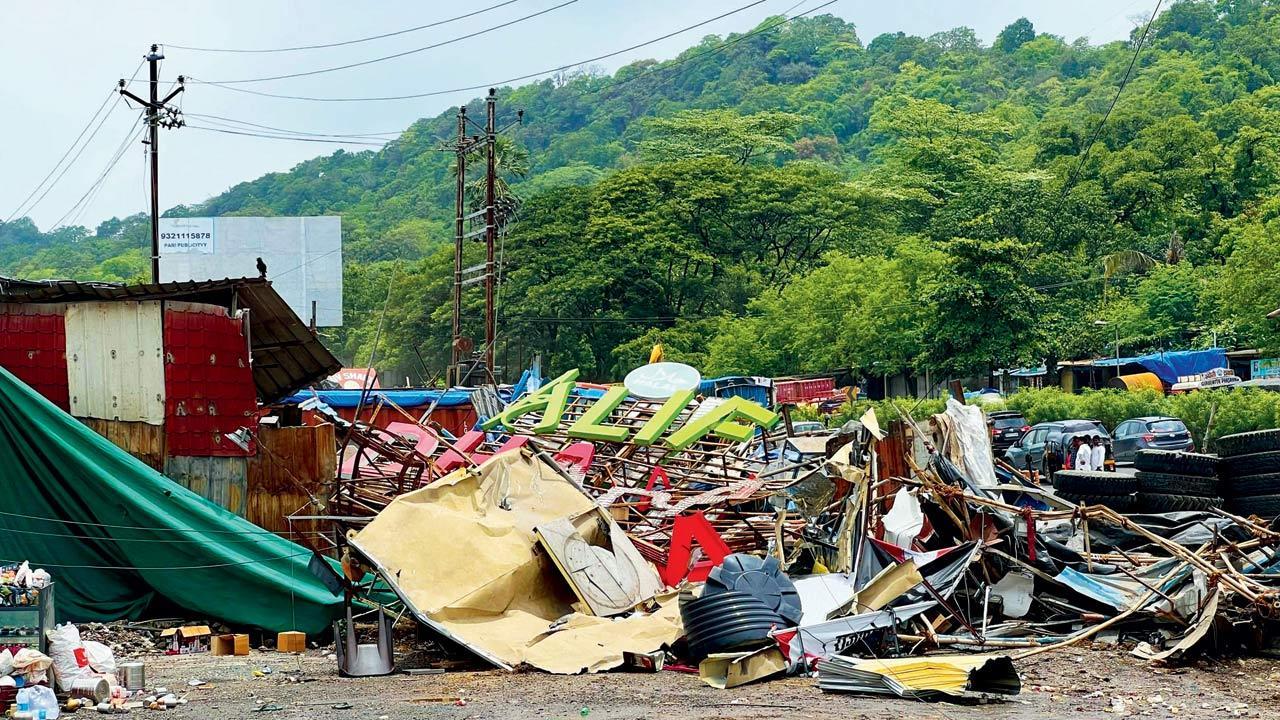Illegal dhabas, hotels, and other establishments continue operating without proper approvals to access the highway, says NHAI official

The action was taken by authorities last year. Pic/Hanif Patel
More than 90 per cent of establishments, including dhabas and hotels along the Mumbai-Ahmedabad highway, do not have the required licence from the National Highways Authority of India (NHAI). Despite this, they continue operating as the civic body allows them to run without final approval from the authority. Following a mid-day cover page story on July 4 last year, NHAI officials have been issuing notices to these establishments. In response to stricter regulations, these businesses have started seeking provisional approval from NHAI for access to NH-48.
Most establishments have been using highway land for entry and exit without obtaining final approval from NHAI, which involves paying a licence fee and other charges. Sumit Kumar, manager (technical) of the Mumbai-Ahmedabad Highway of NHAI, told mid-day, “These dhabas and hotels are running along highway but they have not been granted permission for construction of access to the NH-48. It is the reason, we have been issuing them notices since February. Now, the erring facilities, including dhabas and hotels, have started to approach us with access proposal applications,” Kumar told mid-day.
According to the Ministry of Road Transport and Highways (MoRTH), businesses wanting access to national highways must submit a self-certified proposal for permission. “After we receive the proposal and a Rs 10,000 processing fee, we grant provisional approval. They then need to pay R20,000 and provide a R3 lakh bank guarantee as a security deposit,” explained Kumar.
Kumar added, “Most businesses along the highway have received provisional approvals. They then obtained a commencement certificate (CC) from the Vasai Virar City Municipal Corporation (VVCMC), built their structures, and secured operation certificates to run their businesses.” “However, over 90 per cent of these dhabas, hotels, and petrol pumps do not have the necessary NHAI permission but continue to operate,” Kumar noted.
He said, “We’ve asked the VVCMC commissioner to ensure businesses get final NHAI approval before issuing them an operation certificate for NH-48.” The encroachments along NH-48 caused severe flooding last monsoon, leaving road users stranded for hours. Illegal dhabas, resorts, and other businesses blocked a culvert meant to drain rainwater.
After the mid-day story exposed the issue, authorities, including VVCMC, NHAI, and police, cleared the culvert. However, activists claimed the action was insufficient as only parts of the illegal structures were removed. Many of these businesses have since reopened, continuing to disrupt traffic. Kumar said, “We’ve installed culverts at four locations and plan to add more after the monsoon to address the flooding issue.”
White topping work status
“The highway in the Konkan region receives over 3,000 mm of rain annually, which worsens potholes and maintenance issues, causing traffic jams,” he explained. Started in December 2023, the white-topping project aimed to finish before the next monsoon to prevent traffic problems. “So far, 38 per cent of the work is done, covering over 65 km,” Kumar added.
Issues faced during white topping
>> The white-topping work has been taken up by the contractor at 5-6 locations, with a minimum of 2 lanes kept open for traffic.
>> Simultaneously, the work of 4 VUPs (provided at blackspot/accident spots) has also been taken up on this stretch.
>> The work of replacing pipe culverts with box culverts is also in progress at 4 locations. Box culvert laying is completed, and white-topping is balanced, which will be taken up after the monsoon.
>> Overall, there are 13-14 construction zones on this stretch, and 3-lane traffic is regulated in 2 lanes, leading to congestion for road users.
>> The stretch has very heavy traffic, approximately 80,000 PCU at Khaniwade toll, which increases significantly to 1 lakh PCU in the VVMC area, causing traffic congestion during rush hours.
>> The frequency of breakdowns of heavy vehicles during peak summer was very high, resulting in blockages of already reduced lanes.
 Subscribe today by clicking the link and stay updated with the latest news!" Click here!
Subscribe today by clicking the link and stay updated with the latest news!" Click here!










